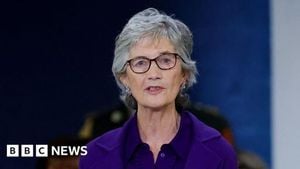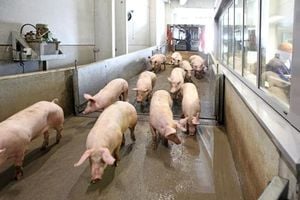In a political season marked by bitter debates over the fairness of America’s elections, two of the nation’s most influential states—Kansas and California—find themselves at the epicenter of a renewed and contentious fight over redistricting. While the details differ, the common thread is unmistakable: both states are wrestling with the temptation to redraw congressional maps in ways that could tilt power, raising fundamental questions about the nature of representation and the health of democracy itself.
Let’s start in Johnson County, Kansas—a place that for decades was synonymous with Republican dominance. According to the Topeka Capital-Journal, Johnson County (or JoCo, as locals call it) once regularly outperformed statewide Republican support. When Dwight Eisenhower swept Kansas with 69% of the vote, JoCo delivered an even more impressive 72.5%. Ronald Reagan? Statewide, 66%. JoCo? 72.4%. Even when Franklin D. Roosevelt captured Kansas for the Democrats, a majority in JoCo stuck with Republican Alf Landon. The pattern was unwavering, right up until the early 21st century.
But cracks began to appear in 2008. That year, JoCo’s Republican vote share lagged the Kansas average by nearly three points—the biggest gap since 1917, which, incidentally, was the last time the county backed a Democrat for president. The trend only accelerated: by 2016, the gap had widened to 10 points. And in 2020, the unthinkable happened—Johnson County flipped blue.
This wasn’t just a presidential phenomenon. Down the ballot, Democrats made significant inroads. In 2018, Laura Kelley trounced Kris Kobach in JoCo by 17 points, even though the statewide margin was just five. Kelley’s reelection saw her claim nearly 60% of the county’s vote. The Democratic delegation in the state House and Senate grew. And perhaps most notably, Sharice Davids rode JoCo’s majority to defeat incumbent Kevin Yoder for the Third District seat, later growing her county vote share to 55%. For the first time ever, a Democratic Senate candidate won JoCo, though Republican Roger Marshall prevailed statewide. Senator Jerry Moran’s JoCo vote share plummeted from 62.1% a decade ago to 46.7% in 2022. And in 2024, Byron Roberson became the first Democrat elected county sheriff in nearly a century.
For Kansas Republicans, these numbers are more than a blip—they’re an existential threat. As Topeka Capital-Journal columnist Russell Arben Fox notes, “The changes have rattled Republicans who recognize further decline could be costly.” Enter the latest proposal: a mid-decade gerrymander that would split JoCo and merge its parts with staunchly Republican districts. The goal is clear—dilute Democratic voting power and blunt the county’s growing political clout.
It’s a high-wire act. Redrawing the maps requires a special legislative session, supermajorities, and plenty of political arm-twisting. Legal challenges are almost certain. And whether Kansans see this as a shrewd political maneuver or an assault on democratic principles largely depends on their partisan leanings. Still, state legislatures do have the authority to redraw districts, and both parties seem ready to flex that power when the stakes are high enough.
But Kansas isn’t alone in this battle. On the other side of the country, California—long celebrated as a beacon of democratic reform—faces its own redistricting storm. As detailed in the Anaheim Investigator, Governor Gavin Newsom has put forward Proposition 50, a bold and controversial plan to redraw congressional maps mid-decade. The explicit aim? Flip five GOP-held seats to the Democrats, overriding the state’s independent redistricting commission and tilting the playing field until 2030.
Newsom justifies the move as a necessary counter to what he calls “MAGA extremists in Texas.” But critics argue that this is less about reform, and more about retaliation—a strategic surrender to the very winner-take-all politics California claims to oppose. As Duane Roberts, editor and publisher of the Anaheim Investigator, puts it, “This is not reform. It’s retaliation. And it exposes the fatal flaw of single-member, winner-take-all districts: our electoral system itself.”
Here’s the crux of the problem: under the current system, each district elects one representative, and whoever gets the most votes—sometimes just a plurality—takes the seat. The rest? Effectively silenced. In competitive districts, nearly half the electorate can end up with no representation at all. In "safe" districts, the dominant party can win over and over, no matter how thin their margin.
Proposition 50, then, is seen by many as a symptom of a deeper disease. The real issue isn’t just gerrymandering—it’s the system that makes gerrymandering so powerful in the first place. When one party can win all the seats with just over half the vote, every line drawn on the map becomes a battle for control, and every voter outside the majority becomes expendable.
So, what’s the alternative? Roberts and other reform advocates point to proportional representation. Instead of electing one winner per district, multi-member districts would allocate seats based on each party’s share of the vote. If a party earns 40% of the vote, it gets roughly 40% of the seats. Minority groups—political, ethnic, or ideological—would finally have a shot at representation without needing to be geographically concentrated or rely on partisan favor.
This isn’t some untested theory. Proportional representation is already the norm in over 130 countries, including Germany, New Zealand, Mexico, and Japan. If California grouped its congressional districts into larger regions, each electing multiple representatives, voters would have more choices, and the incentive to gerrymander would shrink dramatically. As Roberts argues, “Proportional representation would end the gerrymander arms race, ensure fair representation for all Californians, and restore trust in elections.”
Back in Kansas, the stakes are just as high. JoCo’s growing influence means that how its lines are drawn could affect not only local races, but the balance of power in the state and even the nation. Republican leaders hope that by fracturing the county’s Democratic base, they can stall the momentum that has already cost them seats and offices. But the risks are real—a botched gerrymander could backfire, triggering court battles and public backlash.
There’s a certain irony in both stories. California, once the poster child for independent redistricting, now flirts with partisan map-rigging in the name of fighting fire with fire. Kansas, a state where Republicans long called the shots, suddenly finds those same tools of power wielded in a desperate bid to hold on. In both cases, the underlying problem is the same: a system where victory is all-or-nothing, and the temptation to redraw the rules in your favor is almost irresistible.
As the November ballot approaches in California and Kansas lawmakers weigh their next moves, the nation is watching. The outcome could shape not just the next election, but the very rules of the game for years to come. And, perhaps, it will force Americans to confront a difficult question: Should politicians keep drawing the lines, or is it time to redraw the system itself?



